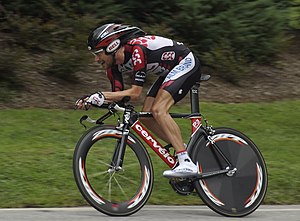Time trial bicycle
This article needs additional citations for verification. (May 2007) |

A time trial bicycle is a racing bicycle designed for use in an individual or team time trials raced on roads but there are also special TT bikes for use in a velodrome.
Distinction between time trial bicycles and others
Since the cyclist in a time trial is not permitted to draft (ride in the slipstream) behind other cyclists, reducing aerodynamic drag of the bicycle and rider is critical. One difference between a time trial bicycle and a road bicycle is the use of triathlon handlebars or aerobars. The main part of the bullhorns curves forward (like a road handlebar), but where the road handle bar curves down, the time trial bar ends. This provides a low tucked position that is aerodynamic while providing good stability. The time trial bar also uses a "clip on" bar or aerobar which attaches to the main bar near the stem and provides a position where the hands and fore-arms are close together, low and forward, providing a very aerodynamic (though less stable) position. The aerobar became popular when in 1989 Greg Lemond made up 50 seconds to defeat Fignon (the race leader) in the final stage (and final time trial) of the 1989 Tour de France. Time trial races tend to be much shorter than road races, so comfort is less of an issue. Also, control of the bike is less important, since there is little chance of bumping another rider and the courses tend to be less technical with little hill climbing, turns or descents.
Other differences from road bicycles:
- Higher gearing. Since time trial races are relatively short, the rider can ride at a higher pace.
- Deep rim or disk wheels, which are more aerodynamic.
- The tubing of the frame may be shaped like an air foil to make it more aerodynamic.
- The top tube is usually a couple of centimeters shorter to give an adequate stem length when riding on aerobars.
- Since time trials are usually flat, more emphasis is placed on aerodynamics than weight and handling.
A time trial bicycle is very similar to a Triathlon bicycle. In fact, because the market for time trial frames is so small, many manufacturers are currently making triathalon bikes that are adjustable enough that they can be setup in such a way that they are legal to ride in UCI events. The main differences are that (1) a triathlon bicycle will sometimes have a steeper seat tube angle (and thus a more forward saddle position), which places less stress on the hamstring leg muscles, thereby saving strength in the hamstrings for the run which follows the bike portion of the race. Several frames come with a seat tube that when installed one way, give the UCI required 5cm distance from the saddle nose to the center of the bottom bracket and when installed the other way gives you better tri geometry (2) some triathlon frames do not meet the strict rules governing the design and overall shape of bicycle frames specified by the UCI and adopted by USCF for use in sanctioned event.
